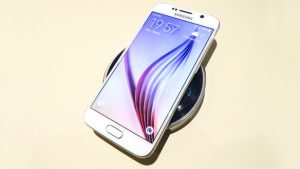Galaxy S6 vs Note 4: Which is best for you?
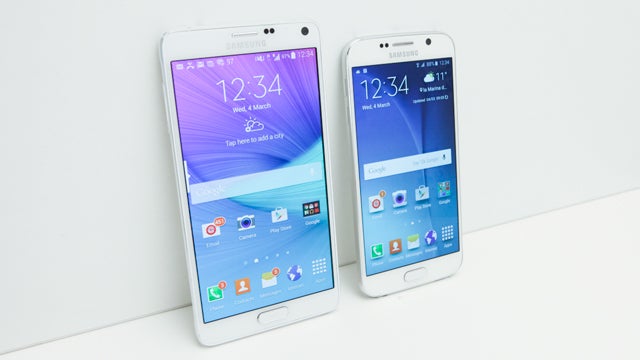
The best of Galaxy from 2014 vs the best of Galaxy 2015. Last year’s Note 4 is still a fantastic device, powerful and versatile, but what does the new Galaxy S6 have to offer that could tempt you to spend a little more money?
With the S6 benefiting from the development of the Samsung Galaxy Alpha as well as the Samsung Galaxy Note 4, surely it will be too advanced for the Note 4 to keep up… but we still love the Note 4. So with that in mind, lets weigh it up against the new kid on the block.
Watch our Galaxy S6 hands-on video
SEE ALSO: Galaxy S6 vs Galaxy S5
Galaxy S6 vs Note 4 – Design
Samsung Galaxy S6: Aluminium frame, Gorilla Glass 4 body, 143.4 x 70.5 x 6.8 mm
Samsung Galaxy Note 4: Aluminium frame, plastic back 153.5 x 78.6 x 8.5 mm
One of the most obvious areas where the Galaxy S6 has departed from its predecessors is in its physical design. Samsung flagship handsets have typically been criticised for not feeling premium enough, with even last year’s Galaxy S5 being overly plastic.
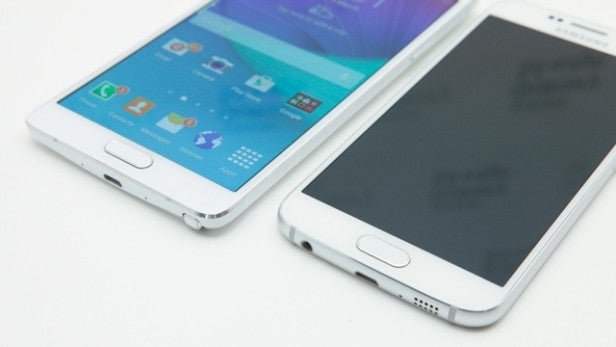
But following on from the S5, Samsung released the contemporary Galaxy Alpha and the classy Note 4 phablet, two devices that felt high-end in almost every way. Both incorporated metal and crafted edges and altogether delivered on the design front, where Samsung’s flagship devices have typically fallen flat.
The Note 4 does have a removable back and an easily accessible microSD card support slot, but the pluses for that phone’s design end there. The S6 has taken some of the elements that made the Alpha and the Note 4 great, then added smooth curved metal edges and Gorilla Glass 4 to the rear.
The result is so aesthetically pleasing that it’ll garner immediate comparisons with Apple’s sleek iPhone 6 and the Sony Xperia Z3. For better or worse, there’s little to pick between the S6 and iPhone 6, which is one of the most highly regarded handsets in terms of design. For that reason the S6 beats the oversized Note 4 for me.
The S6 is 1.7mm thinner, smaller and easier to handle than the Note 4. Side by side it makes the Note 4’s sensible, boxy anodised metal frame look safe and dated.
SEE ALSO: Galaxy S6 vs Galaxy S6 Edge
Galaxy S6 vs Note 4 – Screen
Samsung Galaxy S6: 2K resolution, Gorilla Glass 4, 577ppi
Samsung Galaxy Note 4: 2K resolution, Gorilla Glass 4, 515ppi
This year, Samsung’s flagship S6 gets a resolution bump to match the 2K/QHD 2560 x 1440-pixel display of the Galaxy Note 4.
Considering they’re the same resolution, how do you decide which to go for? Sure, the Note 4’s 5.7-inch screen gives you a bit more screen real estate compare to the 5.1 inches of the S6, but is bigger always better?
Both phones also have Super AMOLED screens, which are superb for displaying deep black tones and high levels of contrast, especially when in the shade. AMOLED screens are also energy efficient, but have the downside of not quite being visible enough when in bright light. But obviously both phones have this issue, so nothing to separate them there.
The one are where the quality of the screens on these devices diverges is the pixel density. They both have 2K screen resolutions, but because the S6’s display is smaller it has a higher pixel density – 577 pixels per inch vs the Note 4’s 515ppi.
For this reason, the Galaxy S6’s screen should appear sharper than the Note 4’s. But at this level and with such fine margins, the differences may be tough to spot. I think we’ll have to call this area a tie.
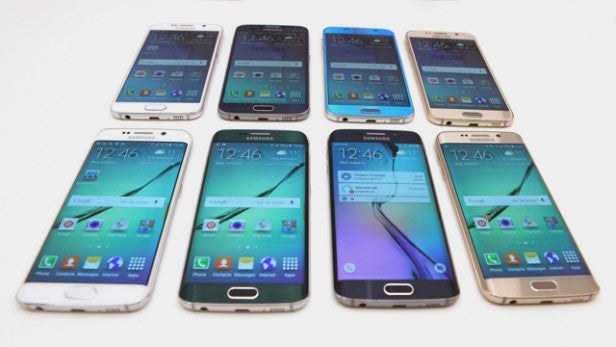
Galaxy S6 vs Note 4 – Connectivity
Samsung Galaxy S6: Wireless battery charging, Bluetooth 4.0, 4G/LTE, Wi-Fi 802.11ac, NFC, Infrared, USB on the go, USB host, Mirror Link
Samsung Galaxy Note 4: Bluetooth 4.0, 4G/LTE, Wi-Fi 802.11ac, NFC, Infrared, USB on the go, USB host, Mirror Link
Wireless charging and speed are the biggest factors here. The S6 will come with widely used Qi/PMA/WPC standard wireless charging. That means that if you have an existing wireless charging pad, it’ll likely be compatible with the new Galaxy S6, which is pretty cool.
Other than that, both phones offer a similar set of connectivity options, including Bluetooth 4.0 for speedy and secure wireless connections to increasingly popular wearables such as smartwatches. Bluetooth 4.0 is also better for enjoying stereo audio, as it can transfer a larger amount of data in less time than the older standards. It’s also less of a drain on battery power.
Furthermore, the newer Bluetooth standard enables tap NFC features, which are convenient ways of linking and sharing data across devices.
With both phones supporting 4G/LTE connectivity as well, it looks pretty even, but the S6 edges the Note 4 because of the wireless charging.
SEE ALSO: Galaxy S6 vs HTC One M9
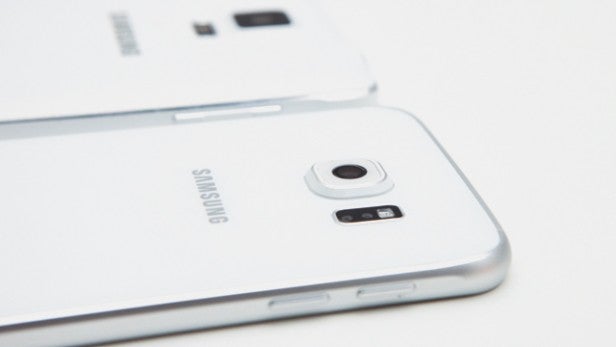
Galaxy S6 vs Note 4 – Performance
Samsung Galaxy S6: 64-bit 2.1GHz octa-core Exynos 7420 chipset, 3GB RAM, Universal Flash Storage 2.0
Samsung Galaxy Note 4: 32-bit 2.7 GHZ Quad-core Snapdragon 805 processor, Adreno 420 GPU, 3GB RAM
It’s hard to imagine why you’d need a smartphone to be significantly faster or more powerful than the Note 4 – it’s a beast. It handles graphically intensive 3D games well and barely gets out of third gear when viewing rich media content.
However, there’s a reason why Samsung has opted to not go with the latest Snapdragon 810, the natural successor to the Note 4’s Snapdragon 805 processor. The S6 uses a 64-bit octa-core Exynos 7420 chipset, made by Samsung itself, with 3GB RAM. The new processor is designed to deliver more power with greater energy efficiency. The 14nm Exynos 7420 chip is theoretically 20% faster and 35% more efficient than the 20nm chip used in the Note 4, although it might not turn out quite that way in real-world terms.
It’s a shame to see no microSD support in the Galaxy S6, but the internal memory uses Universal Flash Storage 2.0 which is almost three times faster than the embedded storage commonly used in other smartphones. With performance comparable to SSD drives, the S6’s UFS 2.0 embedded memory has random read speeds up to 12 times faster than typical high-speed memory cards.
The Note 4 managed an impressive Geekbench 3 score of 3162, while the S6 samples that we got our hands on at MWC managed scores between 5201 and 5452. Of course we’ve only tried out pre-production units at this stage, but if the final phone can deliver that level of performance it will be very impressive indeed.
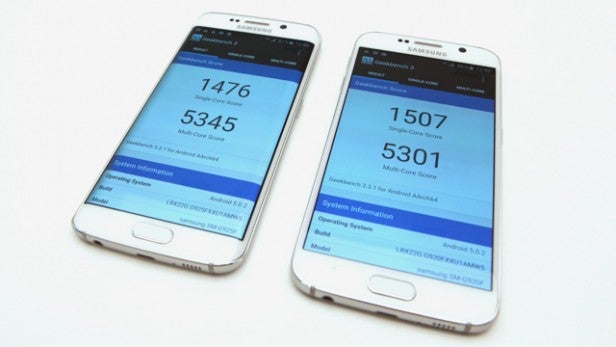
Galaxy S6 vs Note 4 – Software
Samsung Galaxy S6: Android 5.0 Lollipop with overhauled TouchWiz UI
Samsung Galaxy Note 4: Android 4.4 KitKat with TouchWiz UI
The Galaxy S6 runs Android 5.0 Lollipop out of the box, while some Note 4 users are still waiting for their upgrade from 4.4 KitKat.
Both the S6 and Note 4 use the Samsung-tailored TouchWiz UI, which contains some manufacturer pre-loaded apps, also known as bloatware, which some users would simply rather do without. There’s notably less on the Note 4 than we’ve seen on previous Samsung phones, however, perhaps because Samsung is listening to feedback calling for a cleaner Android OS experience. The S6 furthers that cause by only packing three pre-installed Samsung apps – S Health, S Planner and S Voice.
Along with the S6 announcement, Samsung unveiled Samsung Pay, a contactless pay service that’s promised to be compatible with more locations and services than any other competing offering. One of the most interesting features of Samsung Pay is that it’s compatible with old-school magnetic-strip card readers.
Samsung didn’t go into much detail as to exactly how Samsung Pay works, but if it’s as widely accepted as Samsung claims it will be, it’ll be an extremely convenient feature. Crucially, it supposedly works without storing any of the user’s personal or banking details.
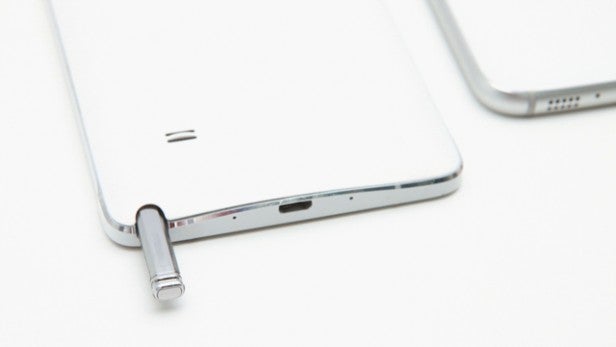
One thing the Note 4 has that the S6 doesn’t is the S Pen, a stylus like no other. The S Pen can be used to navigate around the phone, but it also has a range of productivity-boosting features such as Smart Select that can be used to create scrapbooks from anything displayed on the phone’s screen. Action Memo and Screen Write are great for creating hand-written and content-specific notes on the go. Many Note owners swear by their S Pen and wouldn’t be without it.
Samsung Apps and Google Play provide access to a broad array of applications and games that can be downloaded and accessed via a Google or Samsung account. Both phones win here. Separating the two phones, the Note 4 has S Pen functionality, but the S6 has some advanced future proof tech such as Samsung Pay. I’d say the utility of each handset will depend heavily on what you need your phone to do.
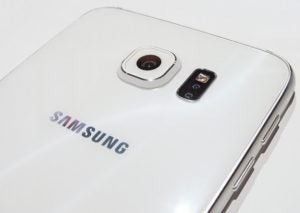
Galaxy S6 vs Note 4 – Camera
Samsung Galaxy S6: 16-megapixel sensor with f/1.9 lens, optical image stabilisation, 5-megapixel front-facing camera with f/1.9 lens, advanced low-light features
Samsung Galaxy Note 4: 16-megapixel sensor, optical image stabilisation, 3.7-megapixel front-facing camera, 4K video recording
Samsung smartphone cameras are known for their quality and the Note 4 is one of the finest. With its 16-megapixel sensor, optical image stabilisation and 4K/UHD video recording, there isn’t much more you could demand from the camera buried inside your phone.
However, the Galaxy S6 has the best features of the Note 4’s camera while also benefiting from bright f/1.9 lenses on both the main and front-facing cameras. Samsung is keen to stress how good the new S6’s camera is, especially during low-light shooting for stills and video.
The early image and video samples from Samsung put the Galaxy S6 a fair bit ahead of the iPhone 6 in terms of performance, so the Note 4 may not be able to keep up. We’ll be sure to do a shootout soon to see the difference for ourselves.
Galaxy S6 vs Note 4 – Battery Life
Samsung Galaxy S6: 2550mAh battery
Samsung Galaxy Note 4: 3220mAh battery
Here’s where the size of the Note 4 is a real advantage – its 3220mAh battery is massive. But remember it still has to power a bigger 5.7-inch QHD screen.
We managed to regularly go two days using the Note 4 on a single charge, which is about as good as it gets with the current line-up of smartphones. But the Galaxy S6, with its energy-efficient processing unit, could manage performance as good as the Note 4’s, despite having a much smaller 2550mAh battery.
Both devices feature Quick Charge technology, which is great, but the Galaxy S6 has the potential to edge the Note 4 here, thanks to some advanced charging capabilities. According to Samsung, 10 minutes of charging can power the S6 for four hours of regular use. But on top of that it also comes with wireless charging as standard. The advancements aren’t huge, but they’re enough to favour the Galaxy S6 over the Note 4 here.
Galaxy S6 vs Note 4 – Price
The Note 4 is only available in a 32GB model and at £599 SIM-free, it doesn’t come cheap. However, we do expect that price may come down a little, following Samsung’s announcement of two new flagship phones.
In comparison, the Galaxy S6 will be offered in a range of prices and capacities – 32GB, 64GB and 128GB – when it becomes available on April 10th. We’re still awaiting official pricing, but we’re expecting it to start at around the €750 mark. Check back with us for updates on pricing and availability.
SEE ALSO: 5 big Galaxy S5 features dropped for the Galaxy S6
Verdict
Some people wouldn’t care which phone is actually better; they’d just want the latest handset, and that’s that. But the Note 4 is still a cracking device that offers a great deal of performance in terms of entertainment, as well as multitasking and productivity thanks to the S Pen. For work and for play, the Note 4 has a lot to offer.
With that said, the S6 is packed full of leading technology and is capable of delivering blistering performance to rival any of the best smartphones currently available. It’s taken some of the best features of the Note 4 and repackaged them in a highly refined, premium body. Samsung has also thrown in a few neat upgrades such as the new camera, Samsung Pay, improved fingerprint recognition and wireless charging, just to sweeten the deal.
The decision comes down to a couple of factors. If you can’t face the size of a proper phablet, the sleeker S6 may be more appealing. If a removable battery and microSD support are must-haves and you’re not a fan of fingerprint-attracting glass, you’ll likely take a hard look at the Note 4.
Both phones will serve you well, and while the Note 4 probably represents the best value for money, the Galaxy S6 has slightly more to offer overall. All in a much more attractive package.


